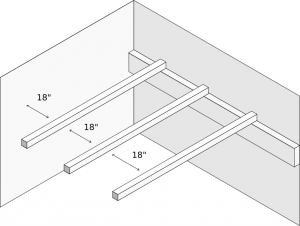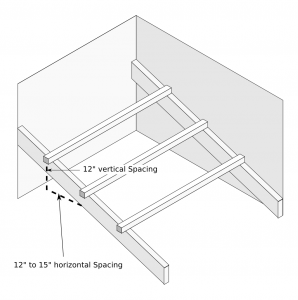 Roost space depends largely on the size of your chickens — how tall, wide and long they are, from beak to tail. There are several considerations that affect how to position the roost and how much space to provide.
Roost space depends largely on the size of your chickens — how tall, wide and long they are, from beak to tail. There are several considerations that affect how to position the roost and how much space to provide.
If a roost is too close to the wall, the chickens will get some manure on it. For large breeds, start the first roost parallel to the wall and about 18″ from it to help keep the wall clean. Consider having making the roosts easy to remove so you can more easily clean and disinfect the coop.
Large, dual-purpose chickens will use up to about 12″ of space (width along the roost) per bird. The more chickens you have, the better use they will make of the available space.
Avoid placing the top roost too close to the ceiling so that your chickens can fly up to the roost and flap their wings as they settle for the night, both without bumping the ceiling.
There are two basic ways to lay out the roosts. If you have ample space in the coop, you may want to lay the roosts out horizontally, with all of the roosts at the same height. In that arrangement, a spacing of 12″ per chicken (width along the roost) and 18″ between roost bars will be adequate.
In a coop where space is more limited, you can save space by staggering the roosts in stair-step arrangement, as shown in the diagram. Place the roosts at least 12″ apart horizontally and 12-15″ apart vertically, as shown.
If the roosts are too close together in this stair step arrangement, lower birds will not be able to avoid droppings from birds above them. For large breeds, avoid this problem by keeping the roosts spaced at least 12″ apart horizontally, and at least 12-15″ vertically to provide enough headroom. Simple things like this, which improve hygiene and reduce stress to your chickens go a long ways toward maintaining a strong, healthy flock.
Finally, it’s best to place your roosts higher than your nest boxes, at least your top roost. The reason: chickens like to roost as high as they can get, and they produce manure all night long. It will be impossible to keep the nest boxes clean if the hens sleep in them. Having your nest boxes lower than the roosts reduces the chance that your birds will roost in them.
As mentioned earlier, the size of your birds determines the space that they’ll need. The above recommendations are for large, dual-purpose chickens. For lighter breeds, like the White Leghorn, or for bantams, you can scale the distances down.





I put Rubbermaid style tubs under my roosting perches and it makes it very easy to collect and take to the compost pile
I am so happy to be getting all of this information now, because I want to get my hens next spring and I want to be sure that every one of their needs is fully met. Just knowing about the roosts and placement of same is good to know. Since I will only be getting 4 hens my work won’t be as hard as someone who is raising a large number of birds; a small number (similar to children) is easier to manage. Thank you for all the help I’ve been getting from the e-mails. I really want to be sure that my hens will have a safe, comfortable and happy life. I also appreciated the information about egg-laying. Since my husband and I are NO SPRING CHICKENS (ha ha ha) our need for eggs will be diminishing as the hens’ production slows down, and hopefully all six of us will retire to a peaceful old age together!
This was fantastic information for someone who just got chicken, but knows nothing about chickens. I was going to have it built at different heights, but one on top of the other, but now realize that won’t work as they will be eliminating on top of each other. Thank you for being so helpful. All I know about chickens is your five minute a day chicken book, but it didn’t cover this. Thanks again.